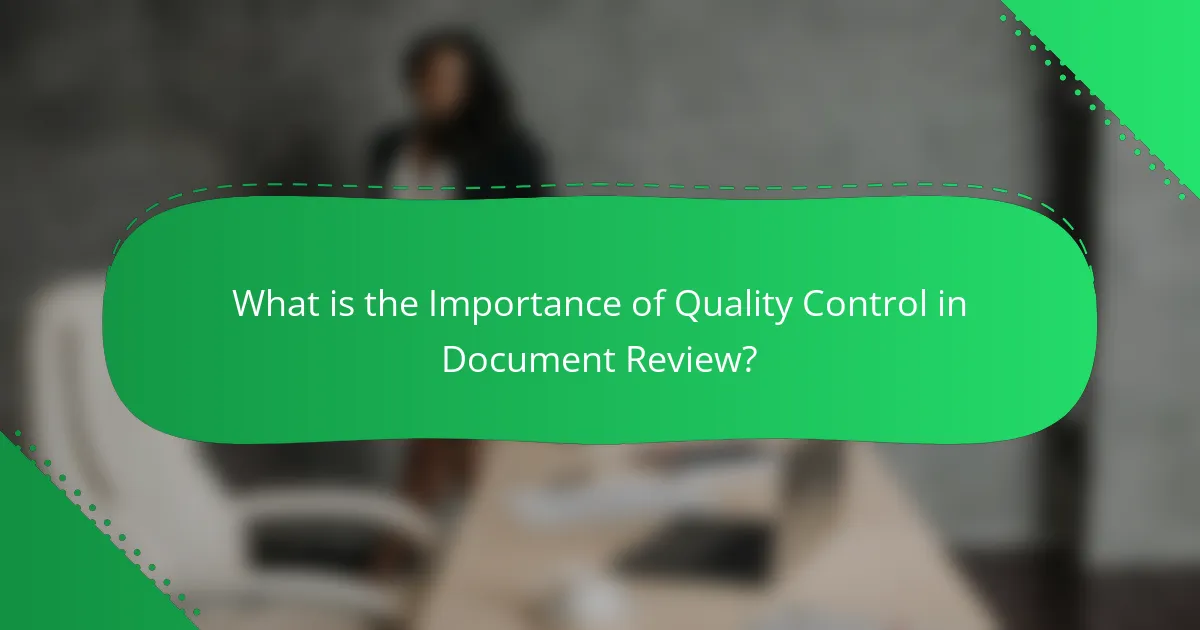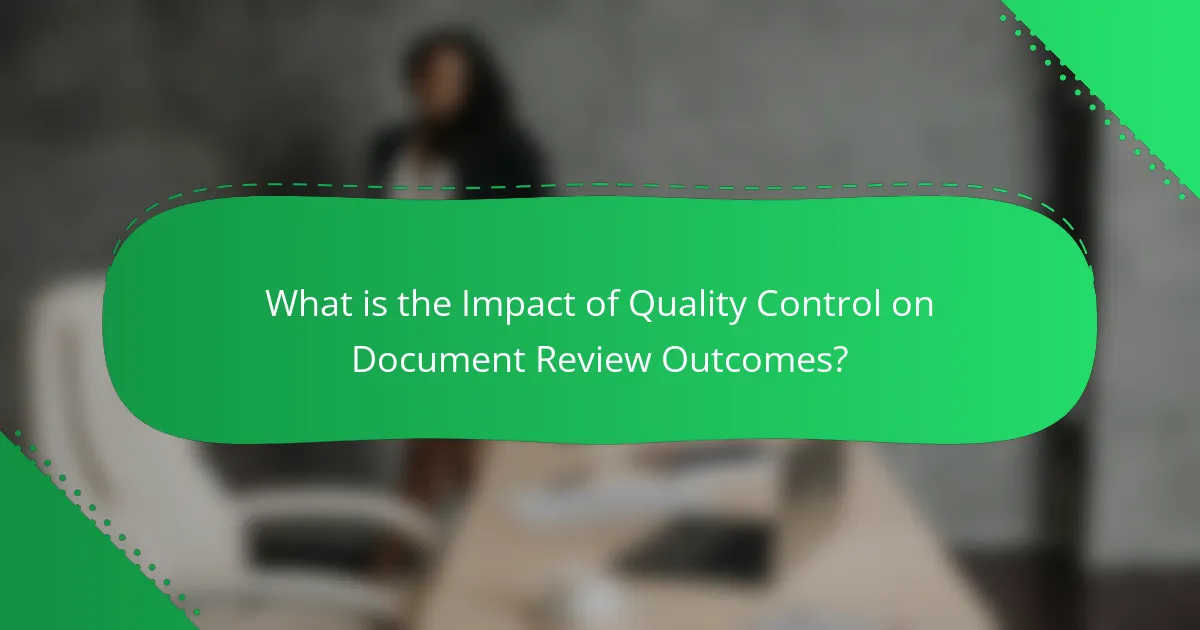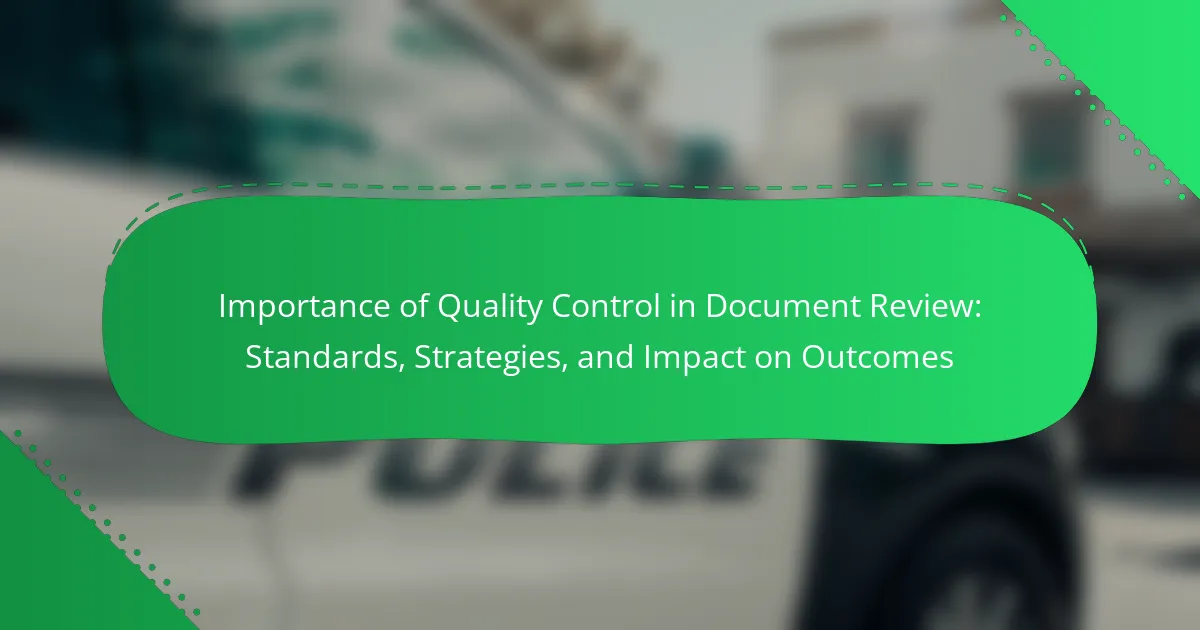Quality control in document review is essential for ensuring accuracy and consistency, significantly reducing errors and enhancing credibility. Effective quality control processes help identify discrepancies before finalization, minimizing miscommunication and legal issues. Key strategies for implementing quality control include establishing clear standards, utilizing checklists, conducting regular training, incorporating peer reviews, leveraging technology for automated checks, and gathering stakeholder feedback. Research indicates that organizations with robust quality control measures experience fewer mistakes, leading to improved operational efficiency and higher client satisfaction. Ultimately, quality control is vital for better decision-making based on reliable information.

What is the Importance of Quality Control in Document Review?
Quality control in document review is crucial for ensuring accuracy and consistency. It helps identify errors and discrepancies before finalization. Effective quality control reduces the risk of miscommunication and legal issues. It also enhances the credibility of the documents produced. Research indicates that organizations with robust quality control processes experience fewer mistakes. This leads to improved operational efficiency and client satisfaction. Quality control ultimately contributes to better decision-making based on reliable information.
Why is Quality Control essential in Document Review processes?
Quality control is essential in document review processes to ensure accuracy and consistency. It helps identify errors, inconsistencies, and omissions in documents. This process enhances the reliability of the reviewed content. According to a study by the American Society for Quality, effective quality control can reduce errors by up to 90%. Implementing quality control measures also increases stakeholder confidence in the documents produced. Overall, quality control is vital for maintaining high standards in document review.
What are the key components of Quality Control in Document Review?
The key components of Quality Control in Document Review include accuracy, consistency, and compliance. Accuracy ensures that the content is error-free and meets specified standards. Consistency involves maintaining uniformity in formatting and terminology throughout the document. Compliance verifies that the document adheres to relevant regulations and guidelines. Additionally, thorough training of reviewers enhances the quality of the review process. Regular audits and feedback loops further support continuous improvement in quality control practices. These components collectively contribute to the reliability and effectiveness of document reviews.
How does Quality Control influence the accuracy of document reviews?
Quality Control enhances the accuracy of document reviews by establishing systematic procedures. It ensures that documents undergo thorough checks for errors and inconsistencies. This process involves defined standards and criteria for evaluation. Regular training and guidelines are provided to reviewers, improving their skills. Quality Control also facilitates peer reviews, allowing for multiple perspectives on the document. Statistical analysis of errors can identify recurring issues in documents. This data-driven approach leads to continuous improvement in review processes. Ultimately, effective Quality Control reduces the risk of inaccuracies in reviewed documents.
What Standards govern Quality Control in Document Review?
Quality control in document review is governed by standards such as ISO 9001 and ASTM E2659. ISO 9001 outlines requirements for a quality management system. It emphasizes continual improvement and customer satisfaction. ASTM E2659 provides guidelines for evaluating the quality of documents. These standards ensure consistency and reliability in document review processes. Adhering to these standards enhances accuracy and reduces errors. Organizations that implement these standards often see improved outcomes in document quality.
Which organizations set the standards for Quality Control in Document Review?
The organizations that set the standards for Quality Control in Document Review include the International Organization for Standardization (ISO) and the American National Standards Institute (ANSI). ISO provides guidelines for quality management systems, including documentation processes. ANSI oversees the development of consensus standards in various industries, ensuring quality and reliability. The Document Management Association (DMA) also contributes by promoting best practices in document management and quality control. These organizations establish frameworks and guidelines that enhance the effectiveness of document review processes. Their standards help ensure consistency, accuracy, and compliance in document handling.
How do these standards impact the effectiveness of document reviews?
Standards significantly enhance the effectiveness of document reviews. They provide a framework that ensures consistency and accuracy in the review process. This consistency reduces errors and improves the quality of the reviewed documents. Furthermore, established standards facilitate better communication among team members. They help in setting clear expectations and responsibilities during reviews. Studies show that teams adhering to defined standards achieve higher compliance rates. For example, organizations that implement ISO standards often report increased efficiency and reduced review times. Overall, standards are crucial for optimizing the document review process.

What Strategies can be implemented for effective Quality Control?
Implementing effective quality control strategies involves several key approaches. First, establish clear quality standards and guidelines for document review. This ensures everyone understands the expectations. Second, utilize checklists to streamline the review process. Checklists help reviewers focus on essential criteria. Third, conduct regular training sessions for the review team. Continuous training keeps skills sharp and knowledge current. Fourth, incorporate peer reviews to enhance accountability. Peer reviews provide additional oversight and diverse perspectives. Fifth, utilize technology for automated quality checks. Software tools can quickly identify errors or inconsistencies. Finally, gather feedback from stakeholders to improve processes. Stakeholder input can reveal areas for enhancement. These strategies are supported by research indicating that structured quality control leads to higher accuracy and efficiency in document review.
How can organizations develop a Quality Control strategy for Document Review?
Organizations can develop a Quality Control strategy for Document Review by establishing clear standards and protocols. They should define specific criteria for document accuracy and completeness. Regular training for reviewers is essential to ensure they understand these standards. Implementing a systematic review process can help catch errors early. Utilizing technology tools for automated checks enhances efficiency and accuracy. Additionally, organizations should conduct periodic audits to assess compliance with quality standards. Gathering feedback from reviewers can provide insights for continuous improvement. This approach leads to higher quality outcomes in document management.
What tools and technologies support Quality Control in Document Review?
Quality control in document review is supported by various tools and technologies. Document management systems streamline the organization and retrieval of documents. Automated proofreading tools enhance accuracy by identifying grammatical errors and inconsistencies. Collaboration platforms facilitate real-time feedback among team members. Version control software ensures that the most current document is being reviewed. Quality assurance software tracks compliance with established standards. Analytics tools provide insights into review processes and identify areas for improvement. These technologies collectively enhance the efficiency and effectiveness of quality control in document review.
How can training enhance Quality Control practices in Document Review?
Training can enhance Quality Control practices in Document Review by improving accuracy and consistency. It equips reviewers with essential skills and knowledge about best practices. Training also familiarizes staff with specific quality standards required for document evaluation. Enhanced understanding leads to better identification of errors and inconsistencies. Regular training sessions can keep teams updated on new tools and methodologies. Research shows that trained employees are 30% more likely to meet quality benchmarks. This results in reduced rework and increased efficiency in document processing. Overall, effective training directly correlates with improved Quality Control outcomes.
What are the best practices for Quality Control in Document Review?
The best practices for Quality Control in Document Review include establishing clear guidelines and standards. These standards should define the scope and objectives of the review process. Regular training sessions for reviewers ensure that they are familiar with these guidelines. Implementing checklists can help reviewers systematically evaluate documents. Peer reviews enhance accuracy by allowing multiple perspectives on the same document. Utilizing technology, such as document management systems, streamlines the review process. Continuous feedback loops improve the quality of future reviews. Regular audits can identify areas for improvement in the review process.
What role does feedback play in improving Quality Control processes?
Feedback plays a critical role in enhancing Quality Control processes. It allows organizations to identify areas needing improvement. Continuous feedback helps in refining procedures and standards. This iterative process leads to higher quality outcomes. For instance, a study by the American Society for Quality found that effective feedback mechanisms can reduce defects by up to 30%. Regular feedback fosters a culture of accountability and transparency. It empowers teams to address issues proactively. Ultimately, integrating feedback into Quality Control processes drives overall efficiency and effectiveness.
How can continuous improvement be integrated into Quality Control strategies?
Continuous improvement can be integrated into Quality Control strategies by adopting systematic methodologies like Plan-Do-Check-Act (PDCA). This approach allows organizations to identify areas for enhancement through regular analysis of processes. Implementing feedback loops ensures that insights from quality assessments are consistently applied to refine practices. Training employees on quality standards fosters a culture of continuous improvement. Utilizing data analytics can highlight trends and areas needing attention, driving informed decision-making. Regular audits and reviews further support the identification of inefficiencies. These methods collectively enhance the effectiveness of Quality Control strategies, resulting in improved outcomes.

What is the Impact of Quality Control on Document Review Outcomes?
Quality control significantly enhances document review outcomes. It ensures accuracy and consistency in the reviewed documents. Implementing quality control measures reduces errors and omissions. Studies show that organizations with robust quality control processes experience a 30% decrease in review errors. This leads to improved compliance with regulatory standards. Additionally, quality control fosters better communication among team members. It establishes clear guidelines and expectations for document handling. Ultimately, quality control contributes to higher overall satisfaction for clients and stakeholders.
How does Quality Control affect the overall quality of reviewed documents?
Quality control directly enhances the overall quality of reviewed documents. It ensures that documents meet established standards and criteria. This process identifies errors, inconsistencies, and areas for improvement. By implementing quality control measures, organizations can maintain accuracy and clarity in their documents. Regular reviews and audits contribute to continuous improvement. Studies show that effective quality control can reduce document errors by up to 50%. This leads to higher stakeholder satisfaction and trust in the documentation process. Ultimately, quality control is essential for producing reliable and effective documents.
What are the measurable outcomes of effective Quality Control in Document Review?
Effective Quality Control in Document Review results in measurable outcomes such as increased accuracy, reduced errors, and enhanced compliance. Accuracy rates can improve to over 95% when robust quality control processes are implemented. Error reduction can lead to a decrease in document revisions by up to 30%. Enhanced compliance with regulatory standards is often observed, ensuring that documents meet necessary legal requirements. Additionally, turnaround times can be optimized, resulting in faster document processing. These outcomes collectively contribute to improved stakeholder satisfaction and overall efficiency in document management.
What challenges are associated with implementing Quality Control in Document Review?
Implementing Quality Control in Document Review presents several challenges. One significant challenge is the variability in document types and formats. Different documents may require unique review criteria. This variability complicates the establishment of standardized quality metrics. Another challenge is the resource allocation for quality control processes. Adequate staffing and training are essential for effective quality control. Limited resources can lead to insufficient oversight and increased errors. Additionally, maintaining consistency across various reviewers can be difficult. Different interpretations of quality standards may arise among team members. Lastly, the integration of quality control tools with existing systems can be problematic. Technical issues may hinder the efficiency of the quality control process. These challenges can ultimately affect the overall quality of document reviews.
How can organizations overcome barriers to Quality Control in Document Review?
Organizations can overcome barriers to Quality Control in Document Review by implementing structured processes and utilizing technology. Establishing clear guidelines ensures consistency in reviews. Training staff on these guidelines enhances understanding and compliance. Utilizing document management systems streamlines the review process and reduces errors. Regular audits can identify gaps in quality control measures. Moreover, fostering a culture of open communication encourages feedback and continuous improvement. Research shows that organizations with structured quality control processes experience fewer errors and improved outcomes.
What practical tips can enhance Quality Control in Document Review?
Implementing a checklist can enhance Quality Control in Document Review. Checklists ensure all necessary elements are evaluated consistently. Regular training for reviewers improves their skills and awareness of quality standards. Using software tools can automate error detection and streamline the review process. Establishing clear guidelines helps maintain uniformity in assessments. Peer reviews can provide additional perspectives, identifying overlooked issues. Setting measurable quality metrics allows for tracking improvements over time. Regular feedback loops foster continuous enhancement of the review process.
The main entity of this article is Quality Control in Document Review, which is essential for ensuring accuracy, consistency, and compliance in document processing. The article outlines the importance of quality control, highlighting its role in reducing errors and enhancing the credibility of documents. Key components such as accuracy, consistency, and adherence to standards like ISO 9001 are discussed, along with effective strategies for implementing quality control, including training, peer reviews, and the use of technology. Additionally, the article examines the measurable outcomes of quality control, the challenges faced in its implementation, and practical tips for enhancing the review process.



